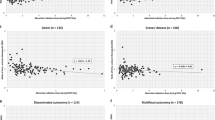Abstract.
Twenty-six patients who had undergone recent surgery for differentiated thyroid cancer were investigated using iodine-131 iodide (120 MBq). Uptake in the thyroid bed was measured at 3 days using a dual-head gamma camera. An ablation activity of 131I iodide (4,000 MBq) was administered 3–38 (median 14) days later and uptake in the thyroid bed measured once or twice, 1–3 days post therapy. For measurements post therapy, the gamma camera was operated in the high-count rate mode with appropriate correction factors to compensate for any count loss. A further 16 patients were given iodine-123 iodide (200 MBq) as the diagnostic agent and uptake was measured at 24 h. The ablation activity was administered 5–47 (median 19) days later and uptake again measured at 24 h. In some cases, a further measurement of uptake was made within the period 1–3 days post therapy. Reduced uptake of the therapeutic administration (P<0.001) was observed in all 26 patients given diagnostic 131I, with a median value of 32.8% (range 6%–93%) of the uptake in the diagnostic study. In the patients given diagnostic 123I, reduced uptake of the ablative radioiodine was observed in 15 of the 16 patients (P<0.001), and overall the median value was 58.8% (range 17%–130%) of the diagnostic uptake. In one case the uptake post therapy was increased. The stunning observed in the group given 123I was significantly less (P<0.001) than in the group given 131I. In the patients given diagnostic 131I, stunning appeared to increase in severity the longer the time interval between the diagnostic and therapeutic radionuclides, for intervals up to 25 days. Thereafter, there seemed to be some recovery of uptake capability. Overall there was no evidence of a large rapid loss of radionuclide from the thyroid bed 1–3 days post therapy. The stunning observed using 123I could not be explained by errors in the estimation of relative uptake due to different tissue absorption of the 131I and 123I photons, nor by the radiation dose delivered by the 123I. However, the ablative 131I itself may cause stunning because the cumulated activity, over the first few hours of uptake, is not insignificant when compared with all the cumulated activity from a diagnostic administration of 131I. The resultant radiation dose to the thyroid remnant, as the therapeutic radioiodine is being taken up, may be sufficient to inhibit the uptake process, thus leading to a reduction in maximum uptake when compared with that of a diagnostic activity of radioiodine.
Similar content being viewed by others
Author information
Authors and Affiliations
Corresponding author
Additional information
Received 1 November 2001 and in revised form 1 February 2002
Electronic Publication
Rights and permissions
About this article
Cite this article
Hilditch, T.E., Dempsey, M.F., Bolster, A.A. et al. Self-stunning in thyroid ablation: evidence from comparative studies of diagnostic 131I and 123I. Eur J Nucl Med 29, 783–788 (2002). https://doi.org/10.1007/s00259-002-0785-6
Published:
Issue Date:
DOI: https://doi.org/10.1007/s00259-002-0785-6



